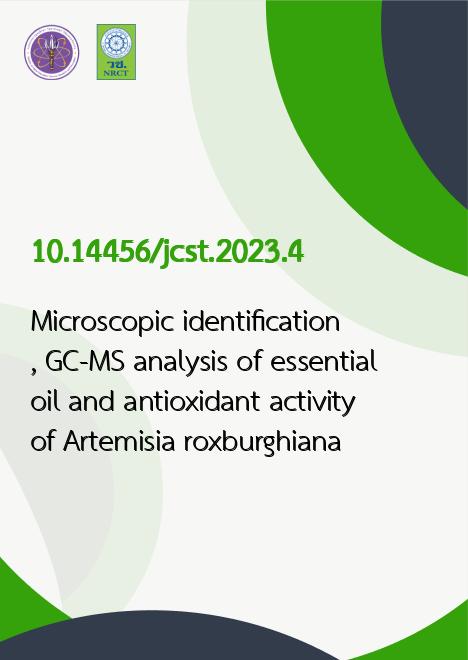
|
Microscopic identification, GC-MS analysis of essential oil and antioxidant activity of Artemisia roxburghiana |
|---|---|
| รหัสดีโอไอ | |
| Creator | Deepak Kumar Semwal |
| Title | Microscopic identification, GC-MS analysis of essential oil and antioxidant activity of Artemisia roxburghiana |
| Contributor | Ankit Kumar, Ravindra Semwal, Ashutosh Chauhan, Ruchi Badoni Semwal, Harish Chandra Andola, Sunil Kumar Joshi |
| Publisher | Rangsit University |
| Publication Year | 2566 |
| Journal Title | ๋Journal of Current Science and Technology |
| Journal Vol. | 13 |
| Journal No. | 1 |
| Page no. | 36-45 |
| Keyword | antimalarial activity, artemisia, essential oil, medicinal plants, microscopy, quality control |
| URL Website | https://jcst.rsu.ac.th |
| ISSN | 2630-0656 |
| Abstract | Artemisia roxburghiana Wall. ex Besser, belongs to the family Compositae, is used as folk medicine against various ailments including diabetes mellitus. An essential oil found in its aerial parts was found effective as an insect repellant. The present study aims to establish the microscopic identification of Artemisia roxburghiana, characterise its essential oil and evaluate its antioxidative effect. The microscopic characterisation of the leaf, stem and root of the plant was carried out using a compound microscope under 4x, 10x, 40x and 100x magnification. The essential oil was isolated by the hydro-distillation method and characterised with the help of gas chromatography-mass spectrometry (GC-MS) analysis. The hydro-alcoholic extract and essential oil obtained from the aerial parts of the plant were evaluated for their antioxidant activity using the DPPH assay. The microscopic studies revealed that the leaf has a single-layered upper epidermis with multicellular trichomes whereas the stem has single-layered epidermal cells, compactly arranged without intercellular spaces. The epidermis of the root is double-layered, thin-walled and colourless without intercellular spaces. The GC-MS studies found α-eudesmole (6.52%), trans sabinene hydrate (6.02%), artemisia ketone (5.97%) and 1,8 cineole (4.92%) as the major volatile constituents present in the essential oil. The hydro-alcoholic extract of the aerial parts also showed DPPH scavenging activity with an IC50 value of 6.90±1.23 mg/mL when compared with rutin (IC50 = 0.65±0.11 mg/mL). The study has successfully established the methods for microscopic characterisation and essential oil analysis of Artemisia roxburghiana. |